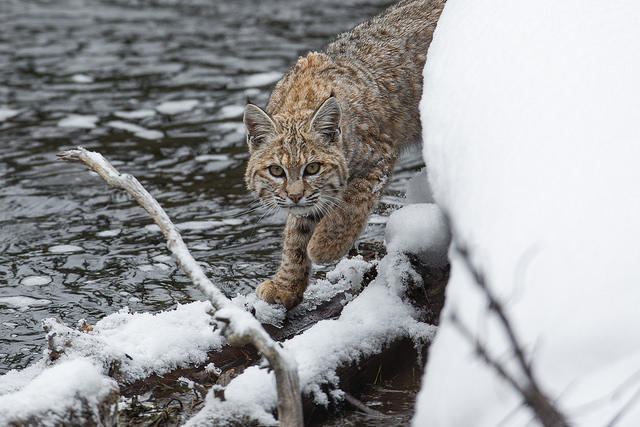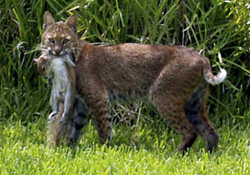https://www.google.com/url?rct=j&sa=t&url=http://nhpr.org/post/unh-researchers-seek-more-answers-bobcats-comeback&ct=ga&cd=CAEYACoUMTU4NTQyMjQ4MTI1ODMyNjM0ODUyGmU3OWU0ODU4MjYwNGNkZDU6Y29tOmVuOlVT&usg=AFQjCNEG7HXEN0_OiHtVyogK2CaVrWq1yA

Monitor staff



UNH Researchers to Seek More Answers on Bobcats' Comeback
University of New Hampshire researchers want to understand why bobcats are making a comeback in the state despite a dramatic decrease in their traditional prey, such as rabbits.
UNH biologists said the population of bobcats in the state may have rebounded to as many 1,400. That led the state Fish and Game Commission to consider a limited bobcat hunting and trapping season. But the proposal received much public opposition and the idea was withdrawn earlier this year

Scientists theorize that bobcats have rebounded, in part, because they have shifted their diet to different prey, such as turkeys and squirrels that hang out beneath bird feeders during the winter.
Bobcat with a Turkey meal

Bobcat with a Gray Squirrel meal

Bobcat with traditional meal of New England Cottontail

To test their hypothesis, they will compare different forms of chemical elements, such as nitrogen and carbon, in possible prey animals with those in bobcat hair.
Bobcat with a Turkey meal

Bobcat with a Gray Squirrel meal

Bobcat with traditional meal of New England Cottontail

To test their hypothesis, they will compare different forms of chemical elements, such as nitrogen and carbon, in possible prey animals with those in bobcat hair.
-------------------------------------------------------
https://www.google.com/url?sa=t&rct=j&q=&esrc=s&source=web&cd=1&cad=rja&uact=8&ved=0ahUKEwjtjcG3iejPAhUG9mMKHfMHDSwQFggcMAA&url=http%3A%2F%2Fwww.concordmonitor.com%2Funiversity-of-new-hampshire-study-investigates-bobcat-populations-5462646&usg=AFQjCNFz2XS7O5KKC-euqg5Gzapdf0WPwQ&sig2=kh6N2fmg6M5HMYOAIjf2qgWhy are N.H. bobcats thriving in a tough environment?
Monitor staff
Tuesday, October 18, 2016
Their habitats are being developed. Their preferred prey are declining. So why is New Hampshire’s bobcat population looking so strong?
That’s the question at the center of a University of New Hampshire study started this month by Marian Litvaitis, a professor of natural resources and the environment. And it may explain about more than just bobcats.
“Identifying the pathways of this success may provide insight into understanding how ecosystems can remain relatively intact as human population continue to expand,” Litvaitis said.
Researchers hope to learn how the state’s estimated 1,400 bobcats have replenished their numbers, given the detrimental factors in their environment. Some estimates put the low point for the species at about 200 animals in 1989, when the state banned trapping and hunting.

The researchers ask: How are bobcats making a comeback “despite a dramatic decrease in their traditional prey such as rabbits and hares.” And how has human development affected bobcats?
“We’re really interested in figuring out why they are able to rebound,” Litvaitis said.
Bobcats seem to have adapted to at least one new form of hunting, Litvaitis said, according to photos residents have sent the researchers.
The predatory cats, which weigh between 15 and 35 pounds, appear to be lying in wait on the outskirts of residential bird feeders. They’re not there for the songbirds, she said, but rather, they wait to pounce on turkeys and squirrels that clean up birdseed that has fallen to the ground.
“The bobcats just kind of ambush them,” Litvaitis said. “It’s pretty remarkable an animal can switch its prey like that. . . . Usually animals are fairly hardwired for their preferred prey.”
She added: “But if you look at house cats, you probably know they’re pretty smart animals.”

Those preferred prey include New England cottontails and hares, which themselves used to have a better habitat in New Hampshire, Litvaitis said.
European settlers cleared New England forests for farmland. Broadly speaking, they then ditched their farms and left the fields to grow young forests, including lots of brush and understory in which the rabbits could hide.
That was good for rabbit populations, and predators follow the prey numerically, Litvaitis said.
But as forests matured, the thicket grew more sparse, and so did the bobcats’ food sources. While the numbers of rabbits and hares remain low, the bobcats may have shifted to other food sources, scientists theorize.
Litvaitis said she’ll test the hair of bobcats found as roadkill in New Hampshire, Vermont and northern Massachusetts to examine isotope signatures and determine the content of their diet.
“Hair is a fairly long-term record,” she said.
She’ll also be able to detect whether bobcats living in more urban areas have higher levels of stress than their rural counterparts, she said, by comparing chemicals in the hair.
“Increased stress has been associated with a decreased immune response and decreased reproductive success in animal populations. Ultimately this may allow for projections about the general health of the bobcat population,” Litvaitis said.
Litvaitis, who has one doctoral student and one undergrad student working with her, said she expects to publish some of the data by November 2017. In the meantime, interested readers can follow along at the university’s bobcat research
website: mlitvaitis.unh.edu/Research/BobcatWeb/bobcats.htm.
----------------------------------------------------------------------------------------------------------

----------------------------------------------------------------------------------------------------------
Restoring a Rare Rabbit

New England cottontails need thick habitat year-round to survive./M. Poole, USFWS
The New England cottontail lives in parts of New England and New York state. Over the last 50 years the range of this once-common rabbit has shrunk and its population has dwindled so that today it needs our help to survive.
A critical threat is the loss of habitat – places where rabbits can find food, rear young, and escape predators. Development has taken much land once inhabited by cottontails and other wildlife. And thousands of acres that used to be young forest (ideal cottontail habitat) have grown up into middle-aged and older woods, where rabbits don't generally live.
Today the New England cottontail is restricted to southern Maine, southern New Hampshire, and parts of Massachusetts, Connecticut, Rhode Island, and New York east of the Hudson River - less than a fifth of its range in the early 1900s.










No comments:
Post a Comment